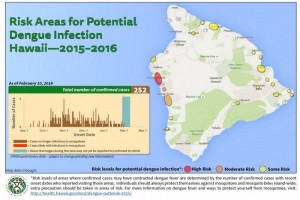No New Dengue Cases Confirmed on the Big Island

The Hawai’i Department of Health updated its map of potential areas of dengue fever infection, based on confirmed case information as of Wednesday, Feb. 10. DOH image.
No new cases of dengue fever were confirmed on the Big Island Wednesday, while one known case currently remains “potentially infectious.” The current total of confirmed cases sits at 252.
The Hawai’i Department of Health has updated its risk area map, listing Kailua-Kona as the sole “high risk” area on the Big Island. Captain Cook, previously listed as “high risk,” is currently listed as “moderate risk,” as is the Keahou area.
Other previous hot spots around the Big Island are currently listed as “low risk” areas.
An additional 17 potential cases of dengue have been excluded from the count since Tuesday afternoon. The total number of cases excluded from the confirmed number totals 1,160. Those cases include individuals who have tested negative for the virus and/or those who have not met case criteria.
Community meetings are being held through the month of February on a weekly basis in both East and West Hawai’i.
Hilo sessions take place on Thursdays at 11:30 a.m. at the State Office Building, located on Aupuni Street. Kona sessions are held at the same time, but at the West Hawai’i Civic Center, Mayor’s Conference Room.
Tuesday sessions are being held at Yano Hall in Captain Cook, beginning at 12:30 p.m.
The community meetings provide updates and answers to questions from the community about the dengue fever outbreak on the Big Island, as well as education about the prevalence, transmission, and symptoms of dengue fever, along with outbreak response efforts, how to interpret case counts and maps, and the best ways to “Fight the Bite.”
Symptoms of dengue fever include fever, joint or muscle pain, headache or pain behind the eyes, and rash.
Those interested in obtaining general information about the current Big Island dengue fever investigation should call 2-1-1 and talk with Aloha United Way.
Anyone who thinks they may have contracted dengue fever on the Big Island should call 933-0912 if they are located in East Hawai‘i or 322-4877 in West Hawai‘i. If an individual is currently ill and concerned that they may have contracted dengue fever, they should contact their primary care physician.
Hawai’i County Civil Defense suggests the following to aid in reducing potential mosquito breeding areas around homes and businesses:
- Remove or eliminate standing water that provides sources for mosquito breeding such as buckets or puddles.
- Fix leaky faucets and outdoor hoses that are dripping water.
- Treat bromeliads and other plants that hold water with a larvacide or chlorine bleach solution.
- Clean gutters to allow water to drain freely.
- Repair screens and windows to help keep mosquitoes out.
- Dispose of old tires at no charge at county transfer stations islandwide.
Mosquito concerns should be reported to 974-6010 in East Hawai‘i or 322-1513 in West Hawai‘i.













